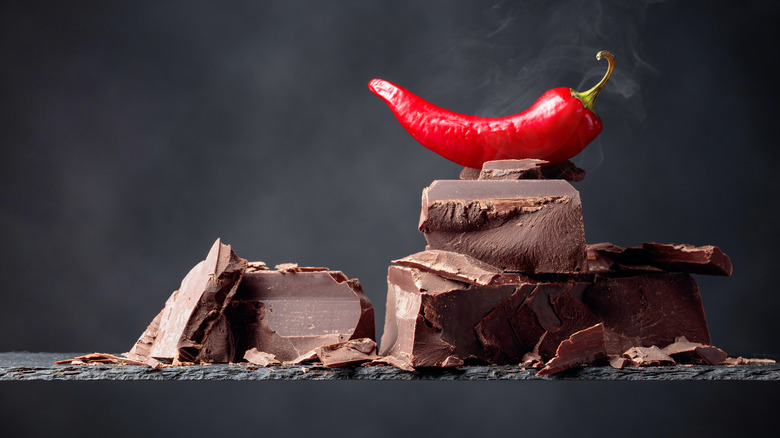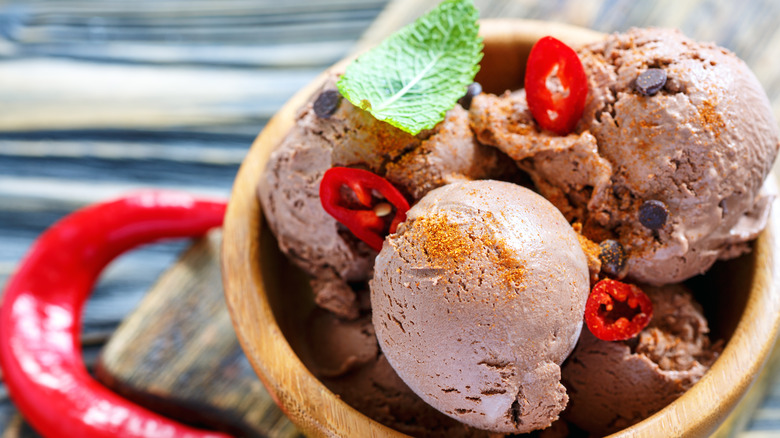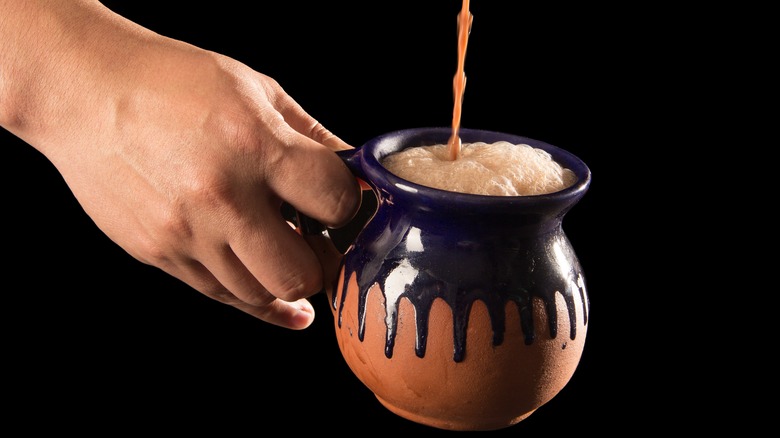Why Chile-Chocolate Ice Cream Is A Bit Of A Gimmick
Even those who prefer to keep spiciness out of their desserts can't deny that chocolate and some of the various types of peppers are a time-honored pairing. The combination of chocolate and chili peppers, which many historians believe predates the ancient Central American Maya people, is a perfect example of two complimentary bold flavors that, had they been introduced in 2024, might inspire the latest TikTok food trend. Indeed, the complexity of the pairing is not lost on contemporary chocolate lovers. Takes on chili and chocolate abound from cakes and candy to cozy libations.
Nevertheless, the combination is not always foolproof. For the best results, you might want to keep the temperature in mind when experimenting with the pairing at home. We're not just talking about the Scoville scale of your chili peppers. To let chilis shine, scientists and chefs alike will tell you to opt for warm desserts over chilled ones. In other words, that expensive pint of chili chocolate ice cream you have in the freezer might not be the best way to enjoy spicy peppers. Here's why.
Cold temperatures dull flavor
In a 2005 paper published in the science journal Nature, Belgian researchers found that flavors light up our taste buds at warmer temperatures. They used ice cream as an example, noting that the dessert "does not taste sweet when it is frozen but only when it is melted in the mouth." This same effect explains why refrigeration can elevate certain red wines. The chilled air subdues the flavors of the wine, which can be a good thing for cheap bottles. The researchers went on to explain how ice cream makers "need to add considerable amounts of sweeteners in order to endow the product with the much rewarding sweet taste."
What does all this have to do with chocolate-chili ice cream? Just like sugar or any sweetening or flavoring agent, the effects of chili peppers are considerably dulled when frozen. That effect, one could argue, takes away the point of putting them in ice cream. On the other hand, much like the process of blooming spices in oil, adding heat to your chilis will bring out their flavor.
Make spicy hot chocolate instead
The next time you feel like spicing up some chocolate at home without much effort, don't bust out your ice cream maker. Instead, collect some hand-crushed dried or powdered chili peppers for a batch of Mexican hot chocolate. Mexican hot chocolate is a Día de Los Muertos essential, commonly enjoyed alongside sweet, eggy Pan de Muerto bread. Long before Mexico got its name, the ancient Maya were known to serve drinking chocolate with chili peppers for breakfast, lunch, and dinner.
Cayenne is a popular and accessible option but you might consider mixing a variety for a more complex flavor. From slightly fruity Aleppo to smoky guajillo and ancho (dried poblano) peppers, any blend of mild chilis will do the trick. Adding warming spices like cinnamon and vanilla will balance out the flavors, as will a dollop of whipped cream on top. If you happen to have a traditional molinillo in your kitchen, that's even better. The wooden whisk has been used to mix Mexican chocolate drinks to a foamy consistency since the 16th century.


